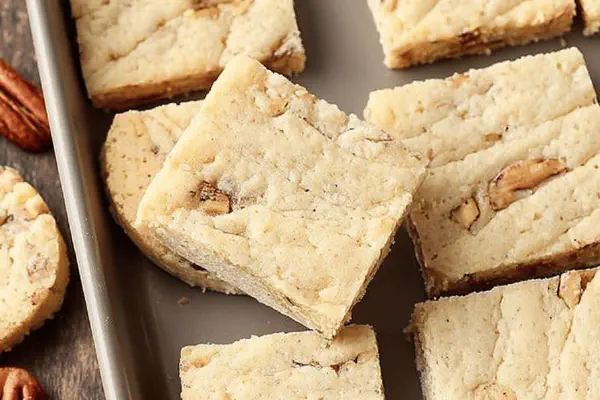Featured Recipe
Zesty Lemon Thumbprint Cookies

By Kate
"
Lemon curd cookies with a zing. Swap cake flour for pastry flour and lemon extract with lime for a twist. Cornstarch replaced by tapioca starch for a chewier texture. Dry mix with flour, starch, baking powder, baking soda and salt. Cream butter with sugar and zest to coax out oils. Add eggs, citrus juice, extracts. Chill dough—flavors meld, dough firms. Roll in sanding sugar then powdered sugar. Thumbprint with spoon, fill with chilled curd. Bake till edges flush golden, tender centers. Rest briefly, nudge edges round with glass to fix wonky shapes. Store in fridge to keep curd stable. Lift flavors, textures with small tweaks and smart timing.
"
Prep:
12 min
Cook:
12 min
Total:
24 min
Serves:
32 small cookies
baking
cookies
citrus
Introduction
Bright citrus, tender crumb, buttery rich, with a gooey lemon curd center. Zest rubbed into sugar, small tweaks change whole cookie profile. Pastry flour swaps out cake flour here, for light but chewy balance across bite; tapioca starch edges chewiness up from corn starch. Lime extract nudges traditional lemon curd into fresh, unexpected territory. Chilled dough firm to handle. Rolling twice in sugar keeps crackle on edges. Thumbprints press shallowly, curd jewel nestled in small dimples. Oven hotter by 5 degrees than usual since dough cold, pushes lift before butter melts away. Smell butter and sugar caramelizing, edges just golden cues pull. Storing chilled stabilizes curd, keeps neat rounds. These cookies play a balancing act between soft, crackly, chewy, tart and sweet—every step honed by kitchen trials that saved me plenty of wasted batches.
Ingredients
About the ingredients
Butter should be room temp for proper creaming; too cold won’t aerate dough, too soft makes greasy dough. Use lime zest and extract as suggested or stick to lemon if no lime handy. Swap pastry flour for cake flour for subtle chewier texture, pastry flour has slightly higher protein—better structure with delicate crumb. Tapioca starch replaces cornstarch for moisture retention and bounce; tapioca makes cookies less crumbly and gives chew, especially important with added citrus acidity. Granulated sugar with zest rubbed releases fragrant citrus oils; don’t skip—raw zest in sugar upfront is a game changer. Egg yolk adds richness and tenderness. Vanilla smooths citrus brightness but keep subtle; too much muddies flavors. Rolling dough balls in two sugars gives a crackled, sugary crust on bake—quality textural finish. Lemon curd ideally homemade; store-bought works but check for no preservatives that could alter bake quality.
Method
Technique Tips
Start lemon curd a day ahead to allow it to set well—too soft curd runs; too firm is hard to spoon. Whisk dry ingredients to prevent lumps; combine them all up front to avoid uneven rising or thick spots in dough. Cream butter and sugar until light colored, not melting but aerated for lift. Citrus zest rubbed into sugar first boosts flavor oils. Add eggs and extracts gradually; avoid over mixing after flour goes in. Chill dough minimum 45 minutes—very important or cookies spread thin and lose shape. A hotter oven than usual counteracts chill; butter solid temp determines spread time. Roll in sanding sugar then powdered sugar for crunchy bite without gritty feel. Use thumb or spoon end to press indentation shallow enough to hold curd but not crack dough. Bake till edges flush golden—watch closely at end; smell and subtle bubbling cues matter so much more than timer. Transfer from hot sheet in a minute to cooling rack to prevent carryover baking. Fix shapes gently with glass spin while warm prevents crispy cookie edges from solidifying unevenly. Store in fridge; lemon curd unstable at room temp.
Chef's Notes
- 💡 For creamy lemon curd, cool it completely. Helps set better. Don’t skip chilling it. Prepping the day before makes it easier.
- 💡 Blend dry ingredients first. Prevents lumps; keeps dough consistent. Dry mix separate means avoid overmixing flour in later steps.
- 💡 Butter needs to be room temp. Not too soft, not too cold. If too cold, won’t aerate well. Rubber spatula for scraping sides helps.
- 💡 When scooping, let dough warm a touch. Cold dough can crack when rolling. Letting it rest briefly means easier handling.
- 💡 Roll cookies twice in sugar. Sanding gives crunch, powdered sugar a sweet finish. Creates nice contrast in texture while eating.
Kitchen Wisdom
Can I substitute the lemon curd?
Sure, berry curds work well. Lime or passionfruit for new flavor. Check thickness.
My cookies spread too much.
Chill dough longer; that helps. Try reducing butter if consistent issues. Or keep mixing less.
Storage tips?
Refrigerate for up to 4 days. Keeps filling from running. If warm, curd can soften. Just give time on counter.
What if dough is sticky?
Chill a bit again after rolling. Or, add more flour gradually. A little goes a long way here.



